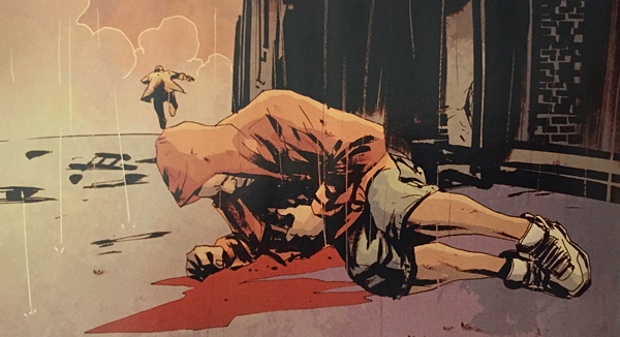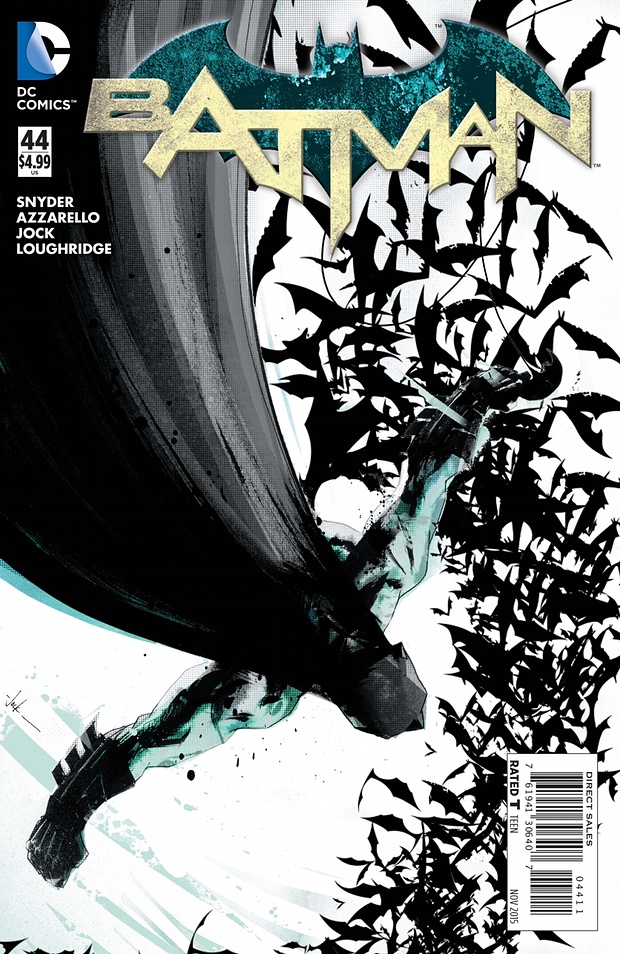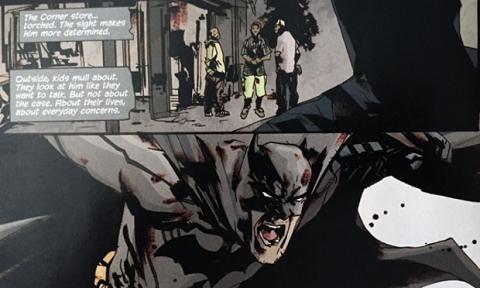People die every day in Gotham City, the fictional hive of corruption where Batman patrols the rooftops. But not until Wednesday did the Dark Knight find himself investigating a black teenager in a hoodie shot dead by a frightened white police officer, let alone wondering about his own indirect role in the boy’s death.
The latest issue of DC Comics’ flagship Batman series throws itself headfirst into the agonizing conversations roiling America more than a year after Ferguson officer Darren Wilson killed 18-year old Michael Brown. The globally iconic superhero confronts racialized police brutality and its intersection with urban poverty and gentrification – problems Batman comes to realize he exacerbates in his secret identity as billionaire industrialist Bruce Wayne.
Comics critics say they are hard pressed to remember Batman ever addressing institutional racism and its socio-economic dimensions as bluntly as this in the character’s 75-year history. While police corruption has long been a feature of Gotham – even showing up on the eponymous Fox TV adaptation about to enter its second season – it it is rarely shown to disproportionately impact black people.
Yet Batman #44, a flashback story, begins with the blunt image of a dead black boy, his body left “for the crows”, as the narration reads, resonant of Michael Brown in Ferguson. He wears a hooded sweatshirt, as did Trayvon Martin before George Zimmerman killed the 17-year old. What begins as A Simple Case – the title of the issue – becomes a meditation on the meaning of a rich, white vigilante who attempts to solve intractable urban problems by beating up bad guys.

The image of a dead black boy in Batman comic #44, wearing a similar hooded sweatshirt to that worn by Trayvon Martin. Photograph: DC Comics
“This issue is meant to be a thesis about what our Batman is,” lead writer Scott Snyder told the Guardian.
“We’ve tried to be pretty relentlessly on-point about him being a symbol of inspiration in the face of tremendous fear, as opposed to a symbol of punishment, or a symbol of revenge, taking the city away from criminals. Here is where he begins to learn [the limits of] the methods that he thought would work: finding a criminal, making an example of the criminal, throwing the criminal in jail … Instead, what he has to learn is that the problems that he’s facing in today’s city are much more humbling, are much more complicated.”
Most controversially, Snyder’s story shows 15-year-old Peter Duggio shot in the stomach by Gotham police veteran Ned Howler. Duggio is shown frightened, emerging from a fight in his father’s bodega with a local gang, and before he can respond to Howler’s demand to lie down, the officer mortally wounds him.
But the story also points a finger at Batman’s unstated assumptions – those that animate the character, and those that animate the metaphor of the superhero crimefighter. The conflict over the bodega boiled over, Peter’s cousin tells Batman, “once Bruce Wayne announced he was gonna develop the neighborhood”. Suddenly, Batman must confront the hubris of his mission to save Gotham, as his focus on individual and not structural answers set into motion the events that led to Howler killing Peter.

The cover of Batman comic #44. Photograph: DC Comics
Snyder said that during the winter he came up with the idea of addressing the intersection of police brutality and gentrification during the series’s current story arc, in which Gotham police commissioner Jim Gordon takes over as Batman. News reports from Ferguson and Staten Island, New York, where police choked Eric Garner to death, helped inspire the story: “If we were going to do an issue that dealt with potent problems that people face in cities that are reflected fictitiously in Gotham, then we want to really put our money where our mouth was and explore something that’s extremely resonant right now, and, I think, tricky, murky waters.”
For help, Snyder turned to Brian Azzarello, whose acclaimed 100 Bullets saga established him as one of comics’ best noir writers. Azzarello said he sought to sharpen the comic’s points about gentrification.
“This thing is such a ripple, the way lives are affected by gentrification. On one hand, yes, you’re cleaning up this area, you’re making it more livable for people. But you’re not saying anything about the people that live there,” said the Chicago-based Azzarello, who remembered how the 2011 redevelopment of the city’s Cabrini Green housing projects left residents “scattered all over the city, just uprooting them, and they had no choice in the matter because they had no money.
“And if you have no money, you have no voice. And we definitely raised that [in the comic],” Azzarello said.
However Fowler, the police officer who kills an unarmed teenager, doesn’t find himself on the receiving end of Batman’s famous rage. Snyder said depicting Batman punching out a fearful officer risked undermining the purpose of a comic book about social problems, while having the ultimate hero of the broader arc be the police commissioner opened up narrative space to address racialised police violence.
“Of course you want Batman to beat this officer up, and be like, ‘How could you?’ But the point of the issue is that wouldn’t solve the problem. Batman throwing the officer off a roof, or throwing the officer in jail, it wouldn’t get to the heart of the matter at all. And that’s the thing I think is ultimately infuriating,” Snyder said.
Azzarello said he preferred the story to “raise the questions and then leave it to the reader to form their own answers and opinions”.
Accordingly, Batman finds himself on one of Gotham’s rooftops, staring out at a city that no longer makes sense to him, as fictionalized versions of newspaper articles on police brutality, institutionalised racism, poverty and gentrification swirl disorientingly around him. Jock, pen name of the UK artist Mark Simpson, said his task was to find a metaphor for Batman’s recognition that Peter’s death lacked simple answers.
“We talked a lot about a visual trick we could use to represent that and landed on the story cutting’s and text blocks, and how they end up entirely clouding vision. He can’t see the city clearly anymore – he has to break away from his old mindset and learn,” said Jock.
That shift in mindset has begun resonating throughout comics, particularly among fans who want to see superheroes address urgent, real-world problems. Much as a new black protest movement is forcing the US to confront the implications of racialized policing, vocal comics readers are prompting publishers to confront the implications of showing mostly white characters written by mostly white creators – particularly when heroes motivated by justice have nothing to say about collective pushes for social justice.
On the Rainbow Hub blog, comics critic Emma Houxbois credited Snyder and Azzarello with ushering in “a brand new era of self awareness and considered approach to what Batman is and how he responds to the environment he finds himself in”.
Houxbois told the Guardian that the issue is “unprecedented” in how the authors “make race, and the impact on black children in specific, central” to Snyder’s four-year reimagining of Gotham as “a place that reflects all of the most urgent issues facing contemporary urban populations, like the destruction of public services, using prisons to house the mentally ill, militarization of police forces, and large scale gentrification in the wake of natural disasters.” The story holds not just Batman but the book’s “white readers accountable for their complicity in the real-world situations that the comic analogises”.
Elana Levin, of the politically-minded Graphic Policy blog and podcast, said she couldn’t remember a mainstream comic before Batman #44 dealing with police brutality within the context of social systems, as opposed to singular dirty cops.
Levin observed: “Mainstream comics have touched on economic justice a lot – in the past more than in the present. At times they’ve directly looked at racism, though never institutional racism without relying on a metaphor like [the X-Men’s] Mutants. By looking at these two pieces together Batman and the reader can get a sense of the complexity of the problems that Batman usually attempts to solve via detective work and Bruce Wayne attempts to solve via so-called ‘charity’. These problems will not be solved by each of those approaches alone – especially not one that treats the criminal justice system as a fair partner when it is not.”
Snyder, Azzarello and Jock all credited the Time Warner-based DC Comics with being “extremely supportive” of the story, as Snyder put it. But the Batman creators don’t intend to drop its themes in a one-off story and leave them alone. Azzarello says he intends to return to them on the forthcoming Dark Knight III, a highly anticipated collaboration with comics legend Frank Miller.
That fits into a broader theme of Snyder’s heralded four-year run on the character: modernizing the Batman myth for a contemporary audience, one concerned with gun violence, catastrophic climate change and terrorism, and less concerned with scaring criminals off into the night.
“Batman is learning he can’t solve problems in the ways he thought he could,” Snyder said. “It’s much more about understanding what people face in their everyday lives: knowing their fears, knowing their anger, and trying to show them, in a way, that they can and we together can fix, or hopefully make baby steps in fixing these problems that seem intractable, entrenched and impossible to overcome.”


Spread the word